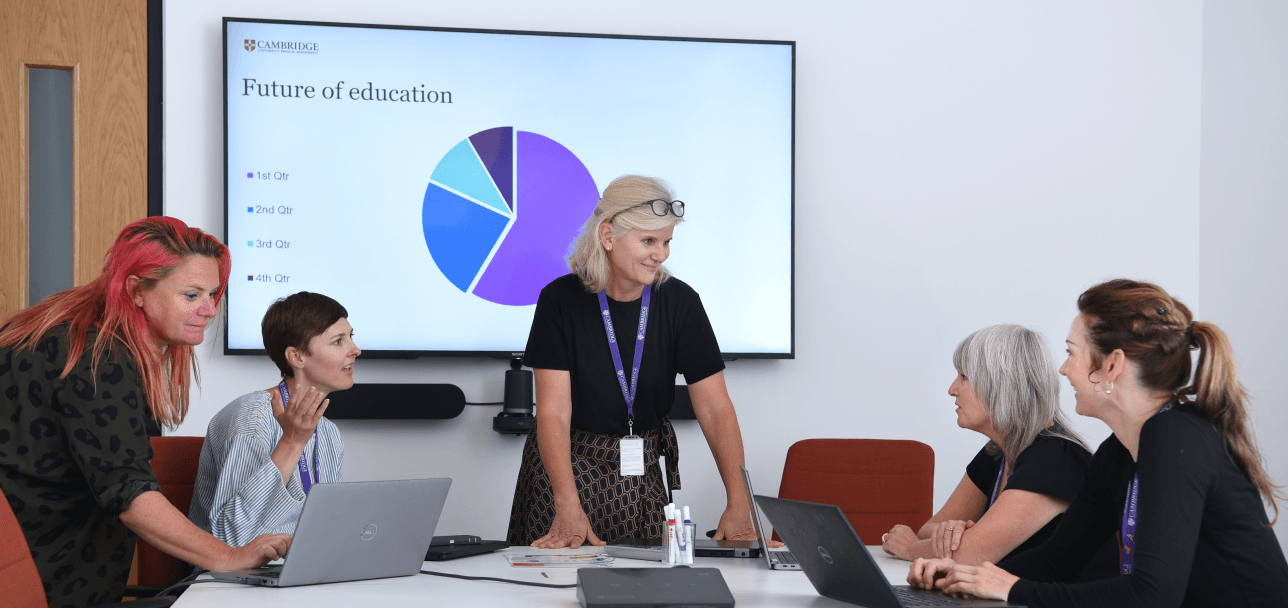Cambridge University Press & Assessment Galvanizes Engagement with Data-Driven Communications
Clever data-driven decision-making combined with targeted, personalized communications proves a game-changer for newly merged organization.
↓

About the organization
Cambridge University Press & Assessment is a world leader in assessment, education, research, and academic publishing. It is part of one of the world’s greatest institutes of education, the University of Cambridge, and shares its mission “to contribute to society through the pursuit of education, learning, and research at the highest international levels of excellence.” Through its products and services, it informs action around some of the world’s most pressing challenges, including climate change, and it helps people around the world to realize their potential, benefiting society and the planet.
Location
Global
Industry
Education
No of Employees
6000 +
INTRODUCTION
In August 2021, global academic research and education publisher Cambridge University Press and worldwide assessment and education experts Cambridge Assessment came together to form a single organization: Cambridge University Press & Assessment.
The integrated organization has over 6,000 employees globally and an internal communications team of 15.
As with any merger, the integration created several operational and communication challenges, which were compounded by the fact that the majority of the integration took place during the COVID-19 pandemic.
THE CHALLENGE
Creating Comms Cut-Through & Engagement During a Time of Change
Because communication can make or break any change initiative, it was decided to integrate the separate internal communication teams of Cambridge University Press and Cambridge Assessment before the integration of both organizations. The successful integration of both internal comms teams would play a critical role in shaping and influencing the overall integration.
The key priority and challenge for the internal communications team was to achieve cut-through with the communications that really mattered during a time of large-scale organizational change and a global pandemic.

This meant bringing topics of most relevance and impact up front and center for our global employee base. In particular, we needed to ensure calls to action were being received and acted upon, while also boosting engagement with people-centered content." —Kate Hughes, Group Internal Communications and Engagement Manager
THE SOLUTION
Data-Driven, Targeted Communications with Poppulo
Cambridge Assessment’s use of Poppulo for its internal comms newsletters prior to the integration was extended to the newly integrated internal comms team and this proved pivotal to overcoming challenges and achieving business objectives.
A few key factors were crucial for this success:
- A highly focused use of analytics in Poppulo that enabled the team to make informed, data-driven decisions
- A decision to consolidate several employee newsletters into a single newsletter every two weeks, reducing information overload
- The ability to target, segment, and personalize relevant content for multiple audiences across different geographies
- Frequent assessment of content performance metrics to guide ongoing newsletter refinement, leading to more prominent positioning of call-to-action (CTA) content
The result has been transformational, with engagement levels above industry and peer benchmarks. The fortnightly newsletter Connect News now enjoys open rates of 85% and click rates of up to 20%. Kate Hughes, Group Internal Communications Manager, led the transformation of the newsletter and is effusive about the role Poppulo has played.
We pretty much live, sleep and breathe Poppulo—it has revolutionized the way we work as an internal comms team, really. The biggest thing for us is the ability to target our comms to deliver relevant content to different audiences, and the data that Poppulo provides about how our comms are performing is invaluable. It really helps inform how we do our comms and gives us insights on where we need to focus more." —Kate Hughes
The internal comms team’s focus on content performance metrics has directly impacted engagement. Since the introduction of the global newsletter for the newly integrated organizations, they’ve conducted regular audits of content performance metrics, with an aim of continual improvement.
Group Internal Communications Officer, Patricia Evangelista (based in Manila), played a big part in the analysis.

After the first 12 issues, we produced a detailed report on engagement using the analytics available to us in Poppulo and presented our recommendations to the wider internal comms team." —Patricia Evangelista
After another dozen issues, they again analyzed the trends in the data and made further recommendations for improvements, bringing the more operationally oriented, “need-to-know” content into focus and giving it more newsletter space while reducing the focus of global news into an “in case you missed it” bullet-pointed format.
This allowed for more individual stories without increasing the overall length of the newsletter, giving maximum priority to the content employees really needed to focus on.
Looking at trends over time enabled us to identify improvements to the newsletter to boost engagement, for example by giving greater prominence to popular content and moving less engaging material to other channels." —Patricia Evangelista
These improvements proved significant, not least because the popular “need-to-know" type content also frequently includes calls-to-action, so achieving increased engagement in this regard meets one of the internal comms team’s key priorities.
Targeting and Personalization
The ability to target, segment, and personalize content is crucial for an internal comms team serving a complex network of different audiences globally.
“One of the best things for us about Poppulo is the extent to which we can target our communications to get the information that is relevant to the right audiences,” said Kate. “This targeting has to be highly accurate and precise, for example on a sensitive topic like bonuses that would require dozens of different messages to multiple audiences in diverse locations globally.”
Adding personalization to newsletter subject lines in January 2023 has further boosted engagement rates.
Targeting and segmentation also helps dial down information overwhelm for employees by delivering relevant information that people are interested in, instead of untargeted generic content that’s not relevant to them.
A dynamic weekly data sync from their HR information system, Workday, to Poppulo enables content targeting by location, product group, and department—and in the newsletter Connect News there is a section targeted exclusively to managers.
Prior to introducing Poppulo, we didn’t have the facility to target, so people were getting a lot of content that wasn’t really relevant to them. But now, with the ability to segment audiences and personalize content, that has all changed and is reflected in our high engagement rates." —Kate Hughes
The IC team also believes that a mix of channels is essential for their comms strategy to be successful. “With a very diverse workforce in terms of geographic location and age demographics, we can’t have a one-size-fits-all approach to our comms channels, because everyone digests content in different ways,” said Kate.
People are individuals and have their preferred ways of consuming content so what we’re always trying to do is publish content across a range of channels and help people find what they’re looking for and need to know." —Kate Hughes
KEY TAKEAWAYS
Cambridge University Press & Assessment has achieved record engagement with its new consolidated newsletter through data-focused content decisions driven by Poppulo analytics—Newsletter open rates of 85%, surpassing industry and peer benchmarks.
The ability to target, segment, and personalize content for multiple audiences across employee cohorts and locations has galvanized engagement levels with more relevant content.
A critical priority to create communication cut-through for the successful integration of two organizations—during a period of large-scale change and turbulence—has been achieved by Kate, Patricia, and the IC team using the Poppulo Harmony platform.
Explore other stories
WPP Enterprise Technology Communications Team Leads the Way with Increased Engagement and Efficiency
Poppulo delivers “night-to-day” change in revolutionizing colleague communication capabilities
Dive deeper into the strategy, use cases, and impact of Norwegian Cruise Line’s 2,900 fleet-wide digital signage network.
As the company expanded its global footprint and adopted a hybrid work model, the need for a scalable, cohesive, and engaging multi-channel internal communications strategy became increasingly important.


